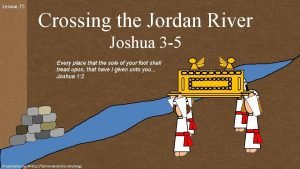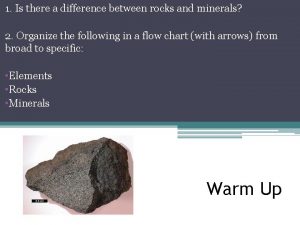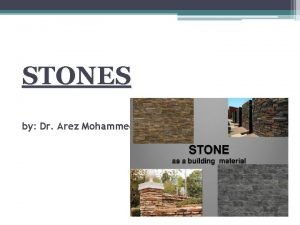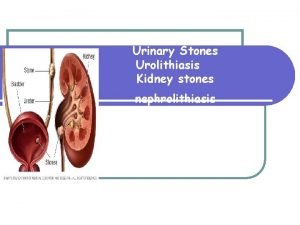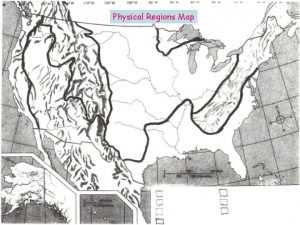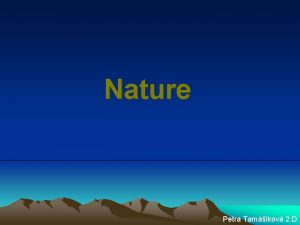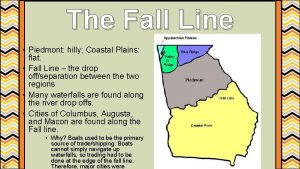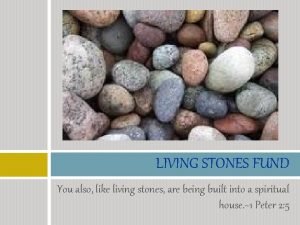Stones Introduction In hilly regions stones are more
































- Slides: 32

Stones - Introduction In hilly regions, stones are more freely available than clay bricks. They occur naturally and need not be manufactured and hence stone masonry becomes cheaper than brickwork. From early days, even before bricks were invented by the humans, stones were used to make dwellings. Old roads with heavy traffic were also paved with stones, Beautiful monuments were also built with stones. Stones were also used for ornamental works. 1/10/2022 1

Stones - Introduction Stones are more permanent than any other natural materials like wood Most of the prehistoric monuments that are today are made of stones Stoned used for heavy engineering constructions like bridge piers, harbour walls, sea side walls And also for facing work, tall buildings, foundations of buildings (which are liable to be flooded – stoned instead of brick work) 1/10/2022 2

Stones - Introduction Today, stones form an important source of aggregate (both coarse and fine) for concrete 1/10/2022 3

Stones and Rocks - Definition Stone can be defined as the natural, hard substance formed from minerals and earth material which are present in rocks Rock can be defined as the portion of the earth’s crust having no definite shape and structure. Some of the rock forming minerals are quartz, mica, dolomite, felspar, etc The various types of rocks from which building stones are usually derived are granite, sandstone, basalt, trap, marble, slate and limestone 1/10/2022 4

Classification of rocks Stones used for masonry construction must be hard, durable, tough and sound. It must be free from weathered patches of material, cracks and other defects Stones for building purposes must be obtained by quarrying from solid massive rocks and not by breaking boulders 1. Geological classification 1. Igneous rocks 2. Sedimentary rocks 3. Metamorphic rocks 2. Physical classification 1. Stratified rocks 2. Un-stratified rocks 3. Foliated rocks – leaves of a book 3. Chemical classification 1. Siliceous – quartz, sand, etc 2. Argillaceous – clay minerals 3. Calcareous – carbonate of lime 1/10/2022 5

Classification Based on Geographical formation Igneous Rocks Also known as primary rock, unstratified or eruptive rocks Formed as a result of solidification of molten mass lying below or above the earth’s surface Eg. granite, basalt, trap, dolerite 1/10/2022 6

Classification Based on Geographical formation Sedimentary rocks Also known as aqueous or stratified rocks The various weathering agencies eg, rain, sun, air, frost, etc break up the surface of earth. Rain water carries down these broken pieces to the rivers and settle in the water because of changes in velocity where the sedimentation takes place in layers and gets consolidated in horizontal beds Rocks are soft, and can be easily split EG. SANSTONE, SHALE, SILT STONE, LIMESTONE, GYPSUM, ETC 1/10/2022 7

Classification Based on Geographical formation 1/10/2022 Metamorphic Rocks Formed from igneous or sedimentary rocks as a result of the action of the earth movements, temperature changes, liquid pressures, etc Can be foliated or non-foliated Foliated (layers)– slate, gneiss, etc Non-foliated (no layers but more colour)– marble, serpentine 8

Classification of rocks based on Physical classification 1. Stratified rocks 2. Unstratified rocks 3. Foliated rocks – leaves of a book Stratified Rocks Show distinct layers along which the rock can be split due to the deposition of organic and inorganic particles. eg. Sandstone, limestone, shale, slate, marble, etc Un-stratified rocks Do not show any stratification and cannot be easily split into thin layers eg. Granite, basalt, trap 1/10/2022 Foliated Rocks Have a tendency to split up only in a definite direction. Eg. gneiss result of heat and pressure Most of the metamorphic rocks except marble and quartzite 9

Quarrying of stones Good stones are obtained by quarrying from solid rock formations and not from loose boulders Boulders are not fit for important constructions Quarry refers to places exposed to air like a stone outcrop from which we extract the building stones. Mine refers to the places where we extract mineral resources like coal, precious stones, etc 1/10/2022 10

Quarrying methods Depends on the type of stone, its use and the type of geological formation If the rock formation consist of horizontal layers at shallow depths, we may be able to quarry them in layers by hand tools If the stone is one whole crystalline masses, we may have to blast them with explosives If we need regular building blocks, we use channeling machines 1. Quarrying with hand tools 2. Quarrying by use of channeling machines 3. Quarrying by blasting with explosives 1/10/2022 11

1. Quarrying with hand tools Old method 1. Digging and excavating – soft stones like laterite using axes, chisels and shovels 2. Heating – layered rocks. If the surface is heated by fire, the differential expansion separates the layers 1/10/2022 12

1. Quarrying with hand tools Old method 1. Wedging – cracks and fissures, steel wedges are driven and the pieces are separated 1/10/2022 13

2. Quarrying by use of channeling machine One of the faces should have an exposed face Channels are made by the channeling machine driven by steam, compressed air or electricity Width – 5 -7. 5 cm Length – 24 m Depth – 2. 4 -3. 7 m Granite and other rocks 1/10/2022 14

3. Quarrying by blasting Does not produce regular sized stones for masonry Blasting using gunpowder (charcoal, saltpetre, sulphur) or chemical explosives – dynamite, blasting powder, cordite, etc 1/10/2022 15

3. Quarrying by blasting Used for the manufacture of stone aggregates or ballast for railways Breaks up the block into irregular blocks and pieces which can be later crushed to give coarse or fine aggregate Can be used for irregular work like random rubble masonry 1/10/2022 16

Natural bed of stone Original bed of formation of the stone is called natural bed Stone should be placed such that the load line is at right angles to the natural bed Seasoning of stone The fresh cut stone has some moisture called quarry sap. The stone has to be dried to make it harder, weather resistant and compact. This drying of stone is called seasoning of stone. 6 -12 months 1/10/2022 17

Dressing of stone A quarried stone has rough surfaces. It needs to be dressed to obtain a definite and regular shape Seasoning of stone The fresh cut stone has some moisture called quarry sap. The stone has to be dried to make it harder, weather resistant and compact. This drying of stone is called seasoning of stone. 6 -12 months 1/10/2022 18

Stone veneering Wall faces are covered with polished tiles or slabs cut from selected stones like sandstone, marble, granite, etc. Such work is called stone veneering 1/10/2022 19

Common building stones and their uses – Uses in buildings Masonry Flooring Roofing Paving roads Aggregates for concrete 1/10/2022 20

Common building stones and their uses S. No. Type of work Stones used 1. Heavy engg. Works – bridge piers, break waters, monuments, etc Fine grained granite and gneiss 2. Masonry work in industrial areas exposed to smoke and fumes Granite, quartzite, compact sandstone 3. Facing work of buildings Marble, granite or sandstone 4. General building work Limestone and sandstone 5. Carvings and ornamental works Fine grained granite, marble and soft sandstone Uses in buildings Masonry 6. Fire resistant masonry Flooring Roofing 7. Floor pavings Paving roads Aggregates for concrete 8. Foundations of buildings with high water 1/10/2022 table Compact limestone and sandstone Marble, slate, sandstone and granite Granite. quartzite 21

Criteria for selection of stones Stone for masonry – for rough work – random rubble Soft stones like lime stones and stone can be dressed more easily than granite Stone for pavements – hard stones of any type – pavings, walkways or drive ways Stone for flooring – heavy duty flooring Granite, marble flooring ( Cant wash with acids) Marble, kotastones can take polish Cuddapa stones - kitchen platforms 1/10/2022 22

Criteria for selection of stones Lime stones Stone for facing work in buildings –attractive colours, durable Impervious stones – granite, marble Pervious stones – lime stones Stone for concrete aggregates – moderate strength – limestone High strength concrete - granite 1/10/2022 23

Lime stones 1/10/2022 24

Sandstones 1/10/2022 25

Slate stone roof tile Slate walls during construction 1/10/2022 Decorative Slate stone wall tile 26

Granite 1/10/2022 27

Marble 1/10/2022 28

Properties of stones 1. Crushing strength 1. Igneous and Metamorphic – 80 -350 N/mm 2 2. Sedimentary – 10 -70 N/mm 2 2. Appearance 3. Density (specific gravity greater than 2. 7) 4. Durability 5. Easiness of dressing 6. Fire resistance 7. Fracture – well cemented and sharp fracture 8. Impact resistance 9. Hardness 10. Resistance to wear 11. Seasoning – Some freshly cut stones contains quarry sap. They should be dressed at freshly quarried stage and should be kept apart (seasoned) for the moisture to evaporate 1/10/2022 29

Deterioration of stones – Main causes 1. Alternate wetting and drying 2. Alternate freezing and thawing (melting) 3. Harmful substances in the air near sea shores or industrial areas 4. Living organisms – growth of vegetation, bacteria or worms that live on rocks 5. Movement of chemicals between materials – Limestone absorb Mg. SO 4 from other stones like sandstone 6. Nature of mortar – chemicals 7. Temperature variation 8. Waterfalls and Rainfalls – falling from great heights or chemicals in it 9. Wind – contain sand dust 1/10/2022 Preservation of stones 1. Linseed oil – raw and boiled 2. Solution of alum and soap 3. Solution of barium hydroxide 4. Paraffin 5. Paint 6. Coal tar 30

Artificial stones 1. Terrazzo 2. Mosaic 1/10/2022 Terrazzo is a man-made conglomerate. A conglomerate is a group of rocks which are cemented together usually using limestone. 31

Artificial stones 1. Terrazzo 2. Mosaic 1/10/2022 Mosaic is the art of covering and decorating a surface or item with small mosaic tiles. Mosaic tiles or tesserae can be made from any hard material – glass, mirror, tiles, pebbles, shells, ceramic shards and more 32
 Lirik lagu more more more we praise you
Lirik lagu more more more we praise you More more more i want more more more more we praise you
More more more i want more more more more we praise you Insidan region jh
Insidan region jh Hedge crickets sing and now with treble soft
Hedge crickets sing and now with treble soft Adaptation in plants for class 4
Adaptation in plants for class 4 The more you take the more you leave behind
The more you take the more you leave behind The more you study the more you learn
The more you study the more you learn Aspire not to
Aspire not to First law of motion examples
First law of motion examples Knowing more remembering more
Knowing more remembering more The more i give to thee the more i have
The more i give to thee the more i have More choices more chances
More choices more chances Human history becomes more and more a race
Human history becomes more and more a race Pathophysiology of kidney stones
Pathophysiology of kidney stones The rolling stones
The rolling stones Stepping stones to glory cartoon analysis
Stepping stones to glory cartoon analysis Stepping stones to glory cartoon
Stepping stones to glory cartoon Large monuments created from huge stone slabs.
Large monuments created from huge stone slabs. 75
75 Stamp collective noun
Stamp collective noun Odowa stones
Odowa stones Whats the difference between rocks and minerals
Whats the difference between rocks and minerals Nursery rhyme sticks and stones
Nursery rhyme sticks and stones Stones bones and petroglyphs
Stones bones and petroglyphs Built of living stones
Built of living stones Cart before the horse
Cart before the horse Summation notation
Summation notation Buy tripe
Buy tripe Rolling stones origin
Rolling stones origin Date and title
Date and title Weihnachtskugel rolling stones
Weihnachtskugel rolling stones Stepping stones portsmouth ohio
Stepping stones portsmouth ohio Magnesium ammonium phosphate stones
Magnesium ammonium phosphate stones


















